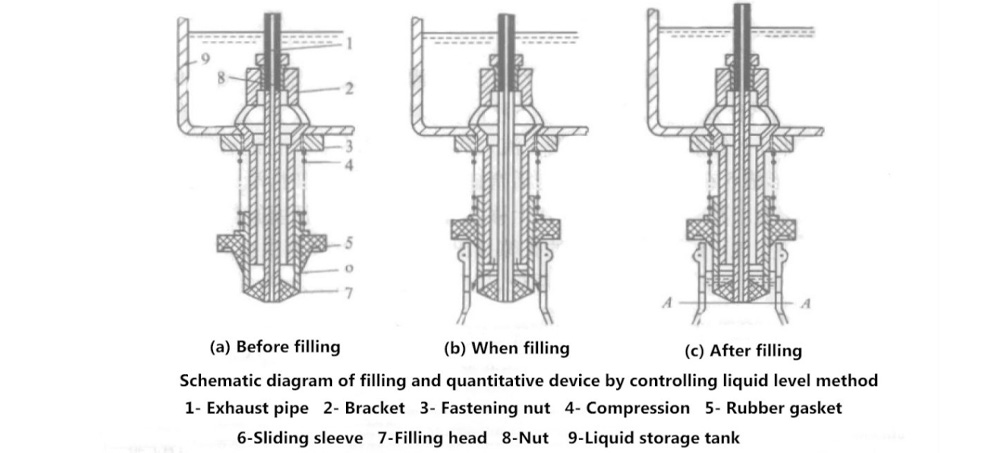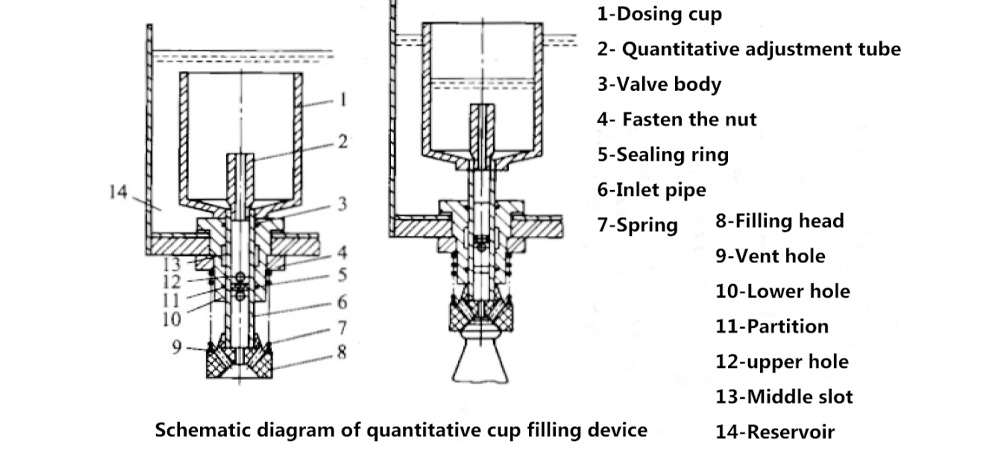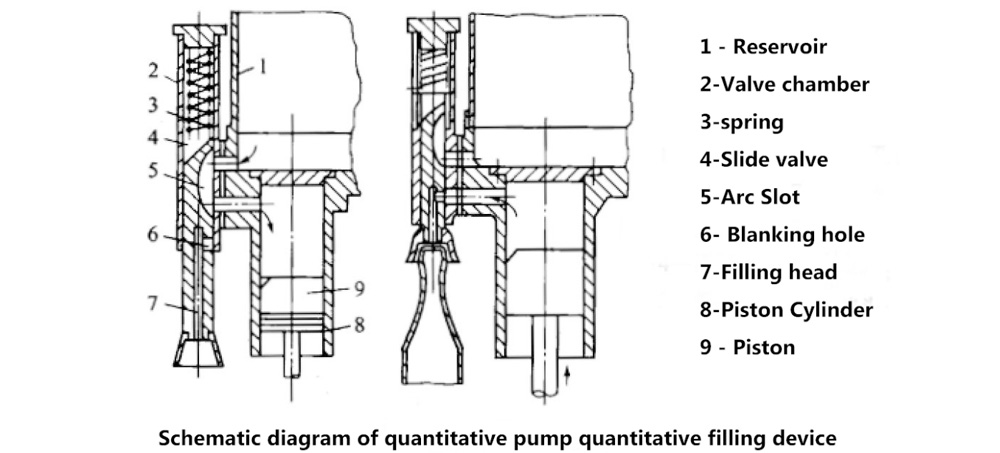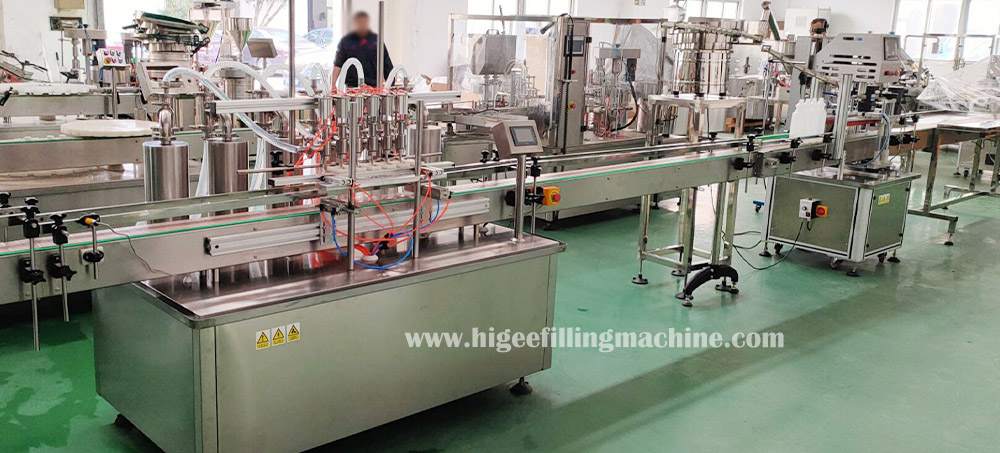1. Quantitative method of controlling liquid level
This method achieves the quantitative value by controlling the liquid level of the filled container (such as a bottle) during filling. It is customarily called “quantitative method by bottle”.
The figure below shows the principle diagram of the filling and quantitative device for filling liquid materials such as milk and juice. When filling starts, the bottle rises, the top of the bottle opens the sliding sleeve 6 with the rubber gasket 5 embedded, and a gap appears between the filling head 7 and the sliding sleeve 6, the liquid material flows into the bottle, and the air in the bottle passes through. The exhaust pipe 1 is discharged to the liquid storage tank 9, as shown in the following figure (b). When the liquid level reaches the nozzle M (section), the gas will no longer be discharged. As the liquid material continues to be poured in, the residual gas in the neck of the bottle is compressed. When it is balanced with the static pressure in the pipe mouth, the liquid level in the bottle remains unchanged, while the liquid material continues along the exhaust pipe. Raise until it is equal to the liquid level of the liquid storage tank, as shown in the figure (c) below. After the bottle is lowered, due to the action of the compression spring 4, the filling head 7 and the sliding sleeve 6 are closed again until the bottle mouth is out of contact with the rubber gasket 5, and the liquid material in the exhaust pipe also drips into the bottle. Thus, one quantitative filling is completed. If the bottle quality and operating conditions are stable, the fill volume will be approximately the same each time. To change the filling amount, use the nut 8 to adjust the position where the exhaust nozzle extends into the bottle.
2. Quantitative Cup Quantitative Method
This method is to inject the liquid material into the quantitative cup first, and then fill it. If the loss such as dripping is not considered, the volume of liquid material filled each time should be equal to the corresponding volume of the dosing cup.
The figure below shows the principle diagram of the quantitative cup quantitative method filling device for liquid materials such as syrup and honey. When the bottle is not lifted, the upper edge of the dosing cup 1 is below the liquid level of the liquid storage tank 14 due to the action of the spring 7 . The liquid material fills the dosing cup 1. Subsequently, the bottle rises and lifts the filling head 8 together with the liquid inlet pipe 6 and the quantitative cup 1 which are fixed to it, so that the upper edge of the quantitative cup 1 exceeds the liquid level, and at the same time, the partition 11 in the liquid inlet pipe 6 and the two sides of the The upper and lower holes 12 and 10 are just located between the middle grooves 13 of the valve body 3 and communicate with each other. Then, the liquid material in the cup flows down from the quantitative adjustment pipe 2, and then flows into the bottle through the upper hole 12 and the lower hole 1. The air in the bottle escapes from the vent hole 9 on the filling head. When the liquid material in the cup drops to the upper edge of the quantitative adjustment pipe 2, one quantitative filling is completed. To compensate or adjust the filling volume, the relative height of the quantitative adjustment tube 2 can be adjusted or the quantitative cup 1 can be replaced.
3. Quantitative pump quantitative method
The quantitative pump quantitative method is a quantitative method using mechanical pressure filling. The volume of each filling material is proportional to the stroke of the piston reciprocating motion.
The figure below shows the principle diagram of the quantitative pump quantitative method filling device for liquid materials such as ketchup. The piston 9 is controlled by a cam (not shown in the figure below) to reciprocate. When the piston 9 moves down, the liquid material flows into the piston cylinder 8 from the bottom opening of the liquid storage tank 1 through the arc groove 5 of the slide valve 4 under the action of its own weight and the air pressure difference between the two cylinders. When the to-be-filled container lifts the filling head 7 and the slide valve 4, the arc groove 5 cuts off the passage between the liquid storage tank 1 and the piston cylinder 8, and the feeding hole 6 of the slide valve 4 is connected to the piston cylinder 8 at the same time. connected. At this time, since the piston 9 is moving upward, the liquid material can be forced from the piston cylinder 8 into the container to be filled. And the air in the container can be discharged through the holes on the filling head 7 . If there is no container supply, although the piston 8 reciprocates, the arc groove 5 on the slide valve 4 remains in place, so that the liquid material is still pressed back to the liquid storage tank 1, without affecting the normal progress of the next filling. If you want to change the filling amount, you need to try to adjust the stroke of the piston 9.
Comparing the above three quantitative methods, it is not difficult to understand that the first method is directly affected by the volume accuracy in the bottle and the sealing degree of the bottle mouth, and its quantitative accuracy is poor, but it has a simple structure and is still widely used.
In fact, the selection of quantitative methods should first consider the quantitative accuracy required by the product, and the accuracy is related to the product. The more expensive the product, the smaller the measurement error should be.
In addition, the selection of the quantitative method should also consider the process characteristics of the liquid material itself. For example, for the filling of carbonated beverages, if the dosing cup method is used, the foam in the liquid storage tank may reduce the dosing accuracy. Therefore, in this case, it is generally more appropriate to use the quantitative method of controlling the liquid level.
*Higee Linear Alcohol filling capping machine line
Higee Machinery is your reliable filling line solution partner, If you have any needs in filling capping labeling and packaging machines, please be free to contact Higee Machinery.
Post time: May-27-2022




